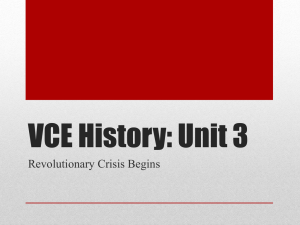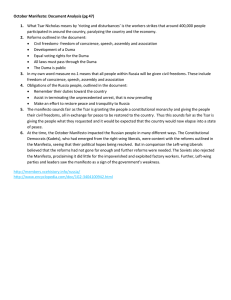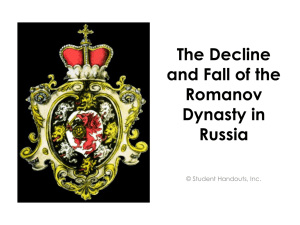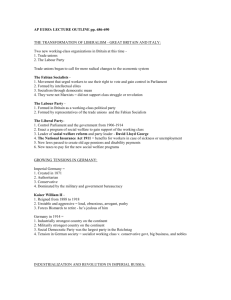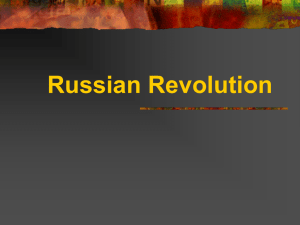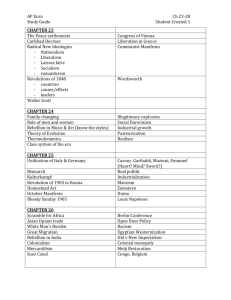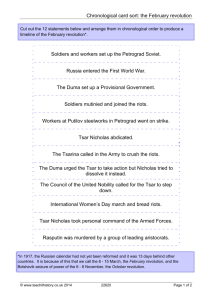The 1905 Revolution: Consolidation Activity
advertisement
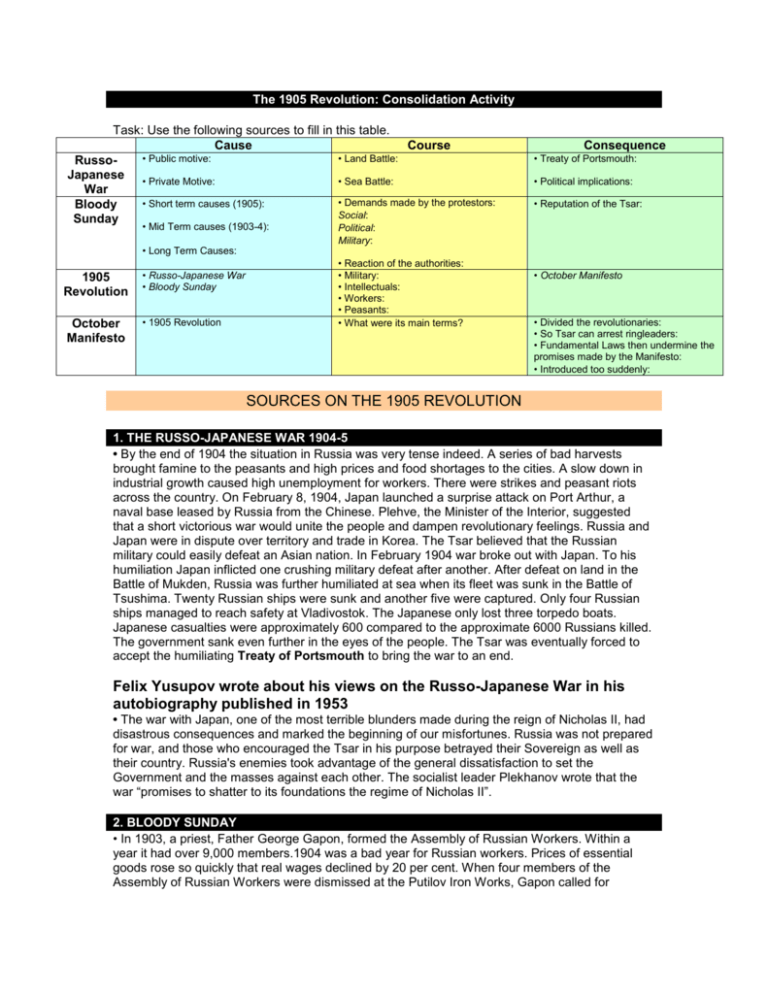
The 1905 Revolution: Consolidation Activity Task: Use the following sources to fill in this table. Cause Course • Public motive: • Land Battle: RussoJapanese • Private Motive: • Sea Battle: War • Demands made by the protestors: • Short term causes (1905): Bloody Social: Sunday • Mid Term causes (1903-4): • Long Term Causes: 1905 Revolution October Manifesto • Russo-Japanese War • Bloody Sunday • 1905 Revolution Consequence • Treaty of Portsmouth: • Political implications: • Reputation of the Tsar: Political: Military: • Reaction of the authorities: • Military: • Intellectuals: • Workers: • Peasants: • What were its main terms? • October Manifesto • Divided the revolutionaries: • So Tsar can arrest ringleaders: • Fundamental Laws then undermine the promises made by the Manifesto: • Introduced too suddenly: SOURCES ON THE 1905 REVOLUTION 1. THE RUSSO-JAPANESE WAR 1904-5 • By the end of 1904 the situation in Russia was very tense indeed. A series of bad harvests brought famine to the peasants and high prices and food shortages to the cities. A slow down in industrial growth caused high unemployment for workers. There were strikes and peasant riots across the country. On February 8, 1904, Japan launched a surprise attack on Port Arthur, a naval base leased by Russia from the Chinese. Plehve, the Minister of the Interior, suggested that a short victorious war would unite the people and dampen revolutionary feelings. Russia and Japan were in dispute over territory and trade in Korea. The Tsar believed that the Russian military could easily defeat an Asian nation. In February 1904 war broke out with Japan. To his humiliation Japan inflicted one crushing military defeat after another. After defeat on land in the Battle of Mukden, Russia was further humiliated at sea when its fleet was sunk in the Battle of Tsushima. Twenty Russian ships were sunk and another five were captured. Only four Russian ships managed to reach safety at Vladivostok. The Japanese only lost three torpedo boats. Japanese casualties were approximately 600 compared to the approximate 6000 Russians killed. The government sank even further in the eyes of the people. The Tsar was eventually forced to accept the humiliating Treaty of Portsmouth to bring the war to an end. Felix Yusupov wrote about his views on the Russo-Japanese War in his autobiography published in 1953 • The war with Japan, one of the most terrible blunders made during the reign of Nicholas II, had disastrous consequences and marked the beginning of our misfortunes. Russia was not prepared for war, and those who encouraged the Tsar in his purpose betrayed their Sovereign as well as their country. Russia's enemies took advantage of the general dissatisfaction to set the Government and the masses against each other. The socialist leader Plekhanov wrote that the war “promises to shatter to its foundations the regime of Nicholas II”. 2. BLOODY SUNDAY • In 1903, a priest, Father George Gapon, formed the Assembly of Russian Workers. Within a year it had over 9,000 members.1904 was a bad year for Russian workers. Prices of essential goods rose so quickly that real wages declined by 20 per cent. When four members of the Assembly of Russian Workers were dismissed at the Putilov Iron Works, Gapon called for industrial action. Over the next few days over 110,000 workers in St. Petersburg went out on strike. • In an attempt to settle the dispute, George Gapon decided to make a personal appeal to Nicholas II. He drew up a petition outlining the workers' sufferings and demands. • Over 150,000 people signed the petition and on 22nd January, 1905, Gapon led a large procession of workers to the Winter Palace in order to present the petition to Nicholas II. When the procession of workers reached the Winter Palace it was attacked by the police and the Cossacks. Over 100 workers were killed and some 300 wounded. The incident, known as Bloody Sunday, signalled the start of the 1905 Revolution. Extract from the petition that George Gapon hoped to present to Nicholas II on 22nd January, 1905. 7 The demands made by George Gapon and the Assembly of Factory Workers. (1) An 8-hour day and freedom to organize trade unions. (2) Improved working conditions, free medical aid, higher wages for women workers. (3) Elections to be held for a constituent assembly by universal, equal and secret suffrage. (4) Freedom of speech, press, association and religion. (5) An end to the war with Japan. Correspondent of the Paris Le Matin The soldiers of the Preobrazhensky regiment, without any summons to disperse, shoot down the unfortunate people as if they were playing at bloodshed. Several hundred fall; more than a hundred and fifty are killed. They are almost all children, women, and young people. It is terrible. Blood flows on all sides. At 5 o'clock the crowd is driven back, cut down and repelled on all sides. The people, terror- stricken, fly in every direction. Scared women and children slip, fall, rise to their feet, only to fall again farther on. At this moment a sharp word of command is heard and the victims fall en masse. There had been no disturbances to speak of. The whole crowd is unarmed and has not uttered a single threat. As I proceeded, there were everywhere troops and Cossacks. Successive discharges of musketry shoot down on all sides the terrorized mob. The soldiers aim at the people's heads and the victims are frightfully disfigured. A woman falls almost at my side. A little farther on I slip on a piece of human brain. Before me is a child of eight years whose face is no longer human. Its mother is kneeling in tears over its corpse. The wounded, as they drag themselves along, leave streams of blood on the snow. Nicholas II, diary entry (22nd January, 1917) A painful day. There have been serious disorders in St. Petersburg because workmen wanted to come up to the Winter Palace. Troops had to open fire in several places in the city; there were many killed and wounded. God, how painful and sad. Peter Kropotkin wrote: The whole character of the movement was changed at once by this massacre. All illusions were dissipated. As the autocrat and his supporters had not shrunk from that wanton, fiendish, and cowardly slaughtering, it was evident that they would stop at no violence and no treachery. From that day the name of the Romanoff dynasty began to become odious among the working men in Russia. The illusion of a benevolent autocrat who was going to listen paternally to the demands of his subjects was gone forever. 3. The 1905 Revolution • In June, 1905, sailors on the Potemkin battleship, protested against the serving of rotten meat. The captain ordered that the ringleaders to be shot. The firing-squad refused to carry out the order and joined with the rest of the crew in throwing the officers overboard. • The sailors sailed into Odessa harbour but were unable to land. Fearing that the Potemkin would be attacked by other ships of the Russian fleet, the mutineers decided to leave Odessa. The crew sailed the Potemkin to Romania where they surrendered to the local authorities. • The Potemkin Mutiny spread to other units in the army and navy. • Industrial workers all over Russia went on strike and in October, 1905, the railwaymen went on strike which paralyzed the whole Russian railway network. Later that month, Leon Trotsky and other Mensheviks established the St. Petersburg Soviet (worker’s council). Over the next few weeks over 50 of these soviets were formed all over Russia. 4. The October Manifesto and the End of the Revolution • Sergei Witte, the new Chief Minister, advised Nicholas II to make concessions. He eventually agreed and published the October Manifesto. This granted freedom of conscience, speech, meeting and association. He also promised that in future people would not be imprisoned without trial. Finally he announced that no law would become operative without the approval of the State Duma. • As the Duma was only a consultative body, many Russians felt that this reform did not go far enough. Leon Trotsky and other revolutionaries denounced the plan. In December, 1905, Trotsky and the rest of the executive committee of the St. Petersburg Soviet were arrested. Others followed and gradually Nicholas II and his government regained control of the situation. Manifesto of 17 October 1905: On the improvement of order in the state • The disturbances and unrest in St Petersburg, Moscow and in many other parts of our Empire have filled Our heart with great and profound sorrow. The welfare of the Russian Sovereign and His people is inseparable and national sorrow is His too. The present disturbances could give rise to national instability and present a threat to the unity of Our State. The oath which We took as Tsar compels Us to use all Our strength, intelligence and power to put a speedy end to this unrest which is so dangerous for the State. The relevant authorities have been ordered to take measures to deal with direct outbreaks of disorder and violence and to protect people who only want to go about their daily business in peace. • However, in view of the need to speedily implement earlier measures to pacify the country, we have decided that the work of the government must be unified. We have therefore ordered the government to take the following measures in fulfilment of our unbending will: 1. Fundamental civil freedoms will be granted to the population, including real personal inviolability, freedom of conscience, speech, assembly and association. 2. Participation in the Duma will be granted to those classes of the population which are at present deprived of voting powers, insofar as is possible in the short period before the convocation of the Duma, and this will lead to the development of a universal franchise. There will be no delay to the Duma elect already been organized. 3. It is established as an unshakeable rule that no law can come into force without its approval by the State Duma and representatives of the people will be given the opportunity to take real part in the supervision of the legality of government bodies. We call on all true sons of Russia to remember the homeland, to help put a stop to this unprecedented unrest and, together with this, to devote all their strength to the restoration of peace to their native land. Reactions to the Manifesto • The introduction of the Manifesto saved the Tsar by splitting the revolutionary groups. Together they had presented a formidable opposition to autocracy. The peasants were granted some relief from their tax burden and some Constitutional Democrats (the Oktobrists) accepted the terms of the Manifesto and began to prepare for the elections to the Duma to be held in 1906. The workers gained nothing from the Manifesto but when the St Petersburg Soviet called for another general strike the liberals refused to back this call. Encouraged by the split between the revolutionary groups the government sent the army in to break up the soviets and arrested their leaders. Leon Trotsky, chairman of the St Petersburg soviet, was sent into exile in Siberia. Lenin and Trotsky both denounced the Manifesto as a sham. In the coming months and years they were proved to be right. The Tsar regains control • Even before the first Duma met Nicholas broke his promise to introduce a Constitutional Monarchy. He declared in his Fundamental Laws published before the opening of the first Duma: 'To the Emperor of all Russians belongs the supreme autocratic power. Submission to his power is demanded by God himself'. This reaffirmation of the Tsar's belief in autocracy contradicted the October Manifesto in many important ways. The Fundamental Laws stated that: the Tsar, not the Duma, would appoint his ministers the conduct of foreign affairs was the responsibility solely of the Tsar the Tsar retained the right to rule by decree [without the elected parliament] the Duma could not pass laws without the Tsar's agreement. • Between 1906 and 1916 there were four elected Dumas. From the start there was conflict between the Duma and the Tsar. There were 450 elected deputies, mostly liberal Kadets, Social Revolutionaries and a few conservatives. • No Bolsheviks or Mensheviks stood for election. Excerpt on the Manifesto from The Memoirs Of Count Witte • The effect of the act of October 17th was in many ways salutary. Thus for instance the Manifesto destroyed the unified front that had made the opposition camp so formidable. It sobered up the country, so that the voice of patriotism was heard in the land again. Propertied people got ready to do battle and rose in defence of their possessions. • But it also had its serious drawbacks. • This historic operation was surely necessary, but it should have been performed with greater care and more precautions. The Manifesto was a bolt from the blue. Most provincial authorities did not understand what was happening, and many clearly lacked sympathy for the new course of policy. Because the Manifesto arrived so unexpectedly, regions that had already been in tension were thrown into a frenzy by it. Violent outbreaks - both revolutionary and counter-revolutionary took place all over the country, the reactionary manifestations involving (of course) anti-Jewish pogroms.
